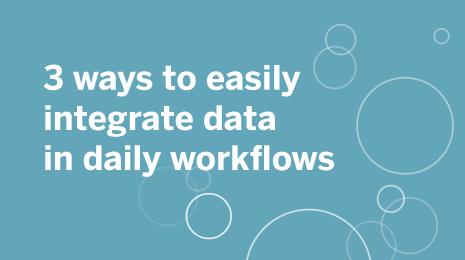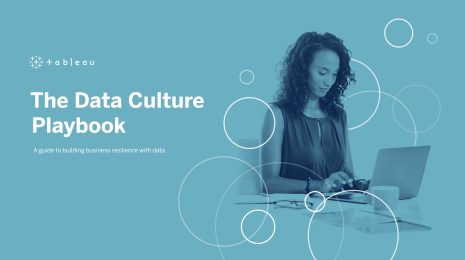Building your data community through empathy
Today's data and analytics tools make it easier for organizations to visualize data quickly and easily. At the same time, an influx of data has left organizations unable to fully tap into their data resources. According to a McKinsey Analytics Survey, only 8% of companies achieve analytics at scale. To bridge the gap, organizations need people who have the analysis skills to explore the data as well as the critical thinking skills to add narrative and context to their findings. Additionally, they need to understand the business context beyond their purview.
Looking back on my data journey, I’ve come to realize that the most important foundation of a data team is a thriving community. As a civil engineer earlier in my career, I was eager to solve problems. I knew that having technical expertise was important to understand data, but it was not the sole requirement. As my career progressed, I took on roles where I collaborated with multiple teams, gathering requirements for product enhancements and data solutions. What I have learned is that businesses that value data literacy need to create ways to immerse their people in the language of data. The most effective way to do this is through community engagement.
Grow data literacy and engagement with data empathy
As organizations become more data-driven they need to understand where the data flows and how it’s being consumed. This exercise requires data empathy—a willingness and a dedication to deeply understand how people use, interpret, and share data. This starts with fostering a community. Community sparks collaboration, which sparks empathy. Data empathy will vary from individual to individual and team to team.
Data empathy also requires a willingness to understand how people feel about data processes. In addition to understanding how the organization consumes data, leaders need to understand how the community feels about the data they’re accessing. For example, do the data sources serve their business needs? Do they have the proper context to interpret the data?
Some questions to ask are:
- Are the analytics tools helping stakeholders perform their jobs better?
- Are dashboards designed appropriately and give the users what they need?
Data communities give everyone in the organization a space to collaborate on complex business challenges and increase data literacy. While culture refers to the beliefs and behaviors that determine how the company interacts with each other and external customers, community goes a step further. It is the sense of belonging and caring for something larger than ourselves. Growing a community is about people not programs or campaigns.
How do you view this data community operating?
Let’s walk through the concept of community and map out how different talents within the organization can collaborate and engage with data.
We’ll start by introducing Mocha, a fictitious coffee delivery company, giving local coffeehouses the specialized technology, data insights, and shared services these small businesses need to serve customers.
Having this platform for local coffee shops helps them compete against major corporate chains. Mocha is looking to sign up more local shops in the San Francisco Bay Area. For the past three months, they have been having monthly analytics readouts. During these meetings, key leaders and stakeholders from the business meet with the analytics team to discuss the prior month’s performance and highlight potential coffeehouses to target for membership. At the end of each meeting, stakeholders have shortlisted coffeehouses that they would like their analytics team to explore, with the ultimate goal to develop an acquisition strategy for coffee shops in the Bay Area.
Currently the team has a working dashboard that tracks the location of prospective coffee shops and their distance to coffee shops already signed up with Mocha. They are also reviewing sales made through the Mocha platform in the Bay area to highlight a few interesting data points to discuss during the meetings. This collaborative process building a sales and acquisition dashboard evokes data empathy among the team.
For starters, it exposes them to talents they might not have. For example, members of the analytics team may not have the business context to decide what coffeehouses would make ideal prospects. They might not be privy to sales projections to vet which locations would potentially qualify as potential customers. At the same time, a subject matter expert might not be familiar with the level of effort it takes to track prospective coffeehouses within a 10-mile radius of current shops on the Mocha platform. Having these monthly readouts help everyone gain an understanding of what each stakeholder does. It also helps them understand how they contribute to the overall strategy.
What are some of the talents that can exist in a data community?
Mocha has a unique and innovative data engagement strategy that encourages collaboration. Based on Scott Berinato’s proposed data operation in “Data Science and the Art of Persuasion”, teams move away from roles and focus more on the individual talent that exists within their community
Most organizations can be broken down into the following talents:
- Subject Matter Experts keep the team focused on business outcomes.
- Project Managers gets all teams to speak the same language.
- Data Wranglers clean, structure, and maintain the data.
- Data Analysts find meaning in the data and apply that to a specific business context.
- Storytellers present data insights as a story and help close the gap between algorithms and executives.
- Designers develop and execute systems for effective visual communication.
Focusing on talent versus roles begins to break the silos in the organization. Once these walls are taken down, innovation can begin to take place. Team members start to step outside their defined roles and tap into all of their skill sets to solve a common problem. As members from the data, sales, marketing, and strategy work together, they begin to see what part they play in the grand scheme of things.
As they contribute their part, they may become curious about another skill set. For example, a data analyst might explore their curiosity in storytelling or developing a presentation that is more visually impactful to their executives. A talent structure allows members of the community to collaborate more freely. As they work together and hear from their peers, they will gain a better understanding of the business context as they map out project goals. As they work to attain these goals, the team will become more familiar with their company’s data. The long-term effect from this is wider data access.
How can data empathy help assess a community’s depth of talent?
Let’s get back to our Mocha example. When Mocha started the dashboard project, there wasn’t an official project manager who was able to work on it in the early stages. Someone in their strategic initiatives group, Randy, spearheaded the process. She was able to bring the stakeholders together to conceptualize what was needed for the sales and acquisition dashboard and how each member of the task force would collaborate to stand it up. Because her team was one of the sponsors for the dashboard, Randy’s facilitation of the project made it easier to relay their requirements to the team. This ensured clear communication on what was needed and resulted in an efficient implementation.
Another great community example from the Mocha team comes from Greg. Greg is a data analyst who possesses strong data wrangling talent. When it comes to creating a data table or setting up the backend of the dashboard, Greg is your guy. Greg, however, gets frustrated with deriving insights or looking for nuances in the data. It’s not his strong suit and with the demands on his time he’s not always able to prioritize it. This experience had a couple of favorable outcomes. Greg’s manager, Daria, was able to find someone who was able to find trends in the data once the dashboard was stood up. This gave Greg time back to focus on where he shines best. Attending the dashboard planning meetings also allowed him to see how all the parts connected. Setting up the data tables for the dashboard enabled the data analysis and provided him with more business insight on Mocha’s operations. He now has context into the data he was working with.
Focusing on community will improve Data Culture
“If you build it, he will come.” This famous line may have worked for Kevin Costner’s character in the 1989 film, Field of Dreams, but this is not good advice for analytics dashboards and platforms. It’s been my experience that when data teams build dashboards without communicating with their stakeholders, it yields disastrous results.
While data teams have expertise in staging and aggregating data, they do not always have the context on the data points that need to be tracked. They will spend hours of effort building something that no one will use. This can be avoided through collaborative data deep dives.
Mocha was not only able to build an effective dashboard during their monthly meeting but an engaging one as well. Getting major stakeholders across the organization to meet was key in understanding the goals and requirements for the dashboard. Having a sense of community established their camaraderie. Working together to formulate a customer acquisition strategy for the Bay Area helped the whole team understand the business context. This helped team members that weren’t privy to this information have a better understanding of how to gather and analyze the data. Bringing these data findings back to the meeting increased the team’s overall familiarity with their data. This can be one manifestation of a beautiful Data Culture!
For more information, read about the five elements of Data Culture or explore The Data Culture Playbook.
関連ストーリー
Subscribe to our blog
Tableau の最新情報をメールでお知らせします






